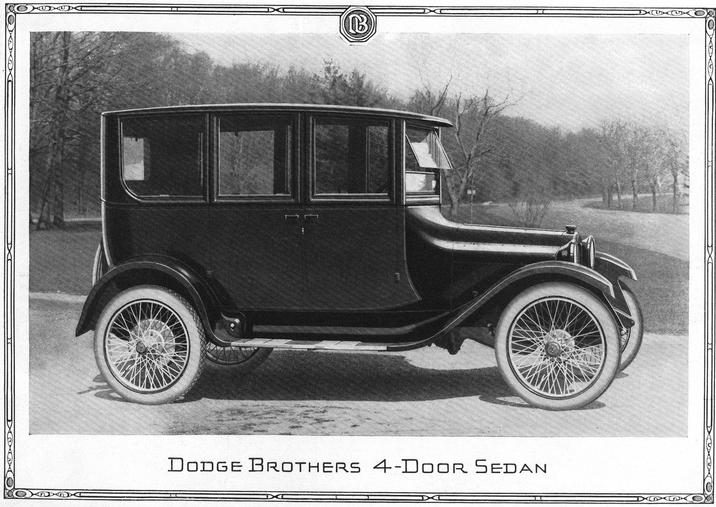The Dodge brand’s storied history dates back nearly 110 years, and it all began in the small town of Niles, Michigan. John Dodge, the eldest of the Dodge brothers, was born in 1864 while his younger brother Horace was born four years later in 1868.

During their younger years, the idea of fast cars wasn’t on the Dodge brothers’ radar, but instead, in 1896, Horace was applying for patents for a dirt-resistant bicycle bearing. Just one year later, in 1897, production for the Evans & Dodge Bicycle Company began.


Already mechanically inclined, in 1901, the Dodge brothers started what would be the largest machine shop in Detroit through their budding bicycle business. A short time later, in 1902, the brothers pivoted to supplying engines, transmissions and axles to major customers like Oldsmobile and Northern. The following year, in 1903, a new partnership emerged with automobile industry newcomer Ford Motor Company.

In 1914, the brothers decided it was time to part ways with Ford and introduce their own car. The first Dodge vehicle, built on an all-steel body (the first of its kind), left the plant on Nov. 14, 1914, and by the end of the year, 249 Dodge vehicles were built.

By 1915, Dodge ranked third among America’s best-selling automakers. Known for “dependability,” Dodge also offered a “winter car” with a removable hardtop and snap-on side glass.
Over the next five years, the brothers produced commercial, civilian and military trucks, along with a 155mm (about 6.1 in) gun recoil system for the Allied armies during WWI. In 1919, Dodge built its 400,000th vehicle, producing a yearly total of more than 100,000 units, all while introducing the brand’s first four-door sedan.


In 1920, at the close of the global flu pandemic that caused more than 550,000 deaths in the U.S. and more than 20 million worldwide in just one year, tragedy struck home. Both John and Horace passed away from influenza. At that time, Dodge was the second best-selling car in America.
During the 1920s, the Dodge Brothers Motor Car Company opened its first Canadian plant, surpassed 200,000 vehicles made in a calendar year, produced its 1-millionth Dodge automobile and was acquired by the Chrysler Corporation.

By 1930, Dodge began production of its first eight-cylinder engine and offered its first factory car radio. The company surpassed 3 million vehicles built and introduced 25th anniversary models with new fastback styling.


Fun Fact: The first 8-cylinder engine by Dodge was produced in 1930 and discontinued in 1934. It was later reinstated in 1952.
Throughout the first half of the 1940s, the automobile industry pivoted to help manufacture items needed to help the war efforts. By 1945, Dodge was back to producing vehicles, making its 5 millionth automobile in 1946. The full-size Dodge Meadowbrook and Coronet were introduced in 1949.

Fun Fact: The Dodge brand turned its production to radar units, Sperry Gyro compasses and engines for B-29 military aircrafts to help with war efforts during WWII.
By 1950, Dodge had launched its first hardtop coupe, the Diplomat, and it was the first time a Dodge vehicle entered a NASCAR race. In 1952, the “Red Ram” HEMI® was introduced, the first V-8 in a Dodge. In the mid 1950s, the Dodge Firearrow Roadster and Dodge La Femme coupe were revealed. By 1958, the final first-generation HEMI was produced for Dodge.


Fun Fact: Specifically marketed to women, the pink-and-white Dodge La Femme coupe included makeup, an umbrella and a rain hat.
In 1960, the world saw the first Dodge Dart, a midsize model. In 1964, the brand celebrated its 50th anniversary, the Dodge Charger concept debuted and the Coronet made another appearance.

The Dodge Challenger made its debut in 1970 and paced the Indianapolis 500-mile race. In 1976, the compact Aspen was introduced and advertised as “the family car of the future.”

Fun Fact: Lee Petty was the first driver to earn a NASCAR victory for Dodge, winning a race in Palm Springs, Florida, in 1953.
In 1981, the Dodge Aries K-car was introduced and was a huge hit, bolstering Chrysler Corporation’s sales for several years. The revolutionary Dodge Caravan minivan was introduced in 1984. The ‘80s ended strong for the Dodge brand with the introduction of the Dynasty in 1988, which became the company’s best seller. In 1989, the brand celebrated its 75th anniversary with the introduction of the Dodge Viper concept, which debuted at the North American International Auto Show in Detroit.


Fun Fact: The Dodge Caravan minivan was nicknamed the “Magic Wagon.”
In the 1990s, the Dodge lineup consisted of several familiar nameplates, including the Dodge Shadow, Daytona, Intrepid, Caravan and Grand Caravan. Rounding out the decade, Dodge introduced the Power Wagon and Charger concepts and celebrated 15 years of the minivan.

With the new millennium came the all-new Dodge Neon, Stratus Sedan and Stratus Coupe, as well as the 2002 Dodge Ram 1500. A big year for the brand, 2003 came with the introduction of the Dodge Magnum, Kahuna and Avenger concept cars, as well as the Tomahawk, a Viper V-10 engine-powered motorcycle. The Dodge Caliber concept was unveiled, and the Dodge Magnum was introduced in 2005. By 2006, a new version of the Charger was introduced, bringing back an iconic nameplate and HEMI power. In 2009, Dodge and Ram became two separate divisions in order to better focus on their own unique customer’ needs.


As part of one of the largest product renaissances, Dodge introduced six all-new or completely redesigned vehicles from 2010 to 2011, including the all-new Durango, Charger, Challenger, Avenger, Grand Caravan and Journey.


On July 1, 2014, the Dodge brand celebrated its 100th anniversary.

Present day is no different than the first 100 years of industry-breaking innovations from the Dodge brothers and their decedents.
Dodge continues to bring passion and horsepower to its lineup of vehicles, which can be found on the dragstrip and among one of the most enthusiastic customer bases in the industry.
The passion of brand followers is on full display at events like the annual MotorTrend Presents Roadkill Nights Powered by Dodge, where thousands of muscle-car enthusiasts gather to talk shop, tour classic lineups and soak up all things that personify the brand’s 100-plus-year history.
While you can still get a healthy dose of speed, burning rubber and HEMI power in vehicles like the jaw-dropping Dodge Demon 170, with its 1,025 horsepower and blazing 0-60 time of 1.66 seconds, you also get innovation and future-facing technology.
The brand has worked tirelessly to give enthusiasts the power they desire, with customization options that truly make a one-of-a-kind Dodge, while working to redefine what future muscle cars look like, sound like and drive like with new concepts, like the battery-electric Dodge Charger Daytona SRT with its patent-pending Fratzonic Chambered Exhaust and the first-ever electrified performance vehicle from Dodge, the 2024 Hornet R/T performance hybrid.


The Brotherhood of Muscle that John and Horace Dodge started more than 100 years ago may have launched on two wheels, but it landed us where we are today, celebrating nearly 110 years of engineering innovation, perseverance and a loyal customer base as dedicated to the Brotherhood as we are.




